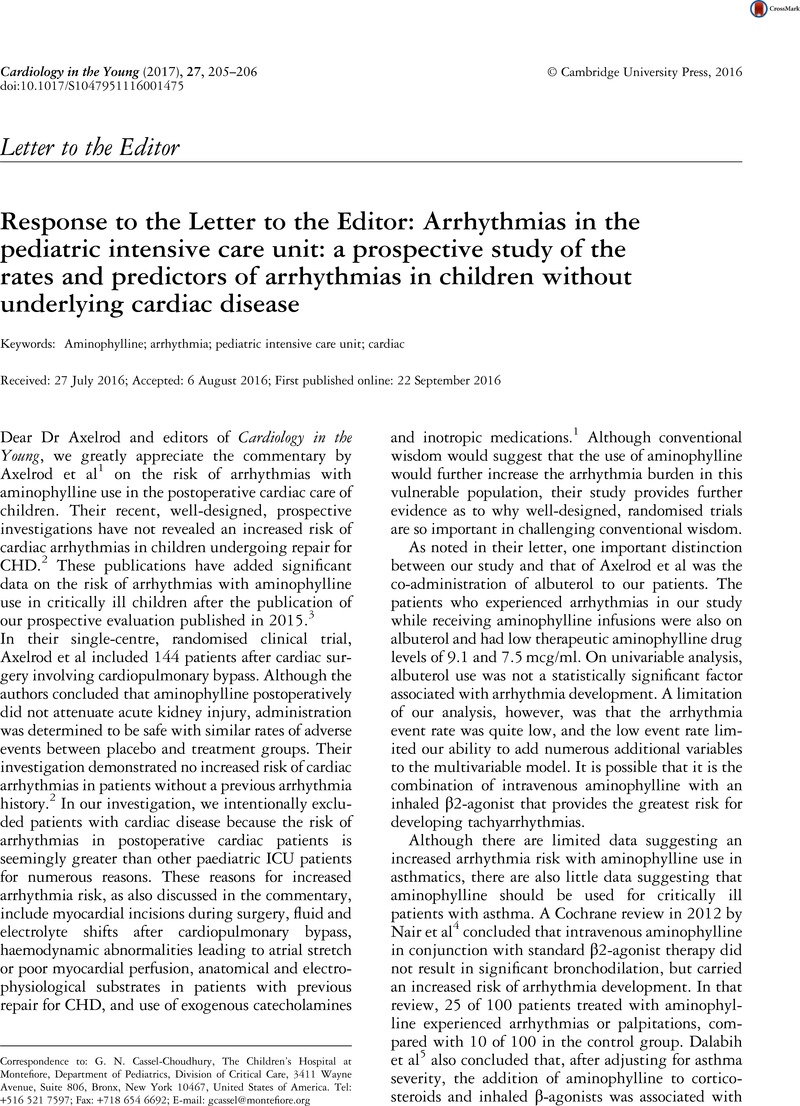No CrossRef data available.
Article contents
Response to the Letter to the Editor: Arrhythmias in the pediatric intensive care unit: a prospective study of the rates and predictors of arrhythmias in children without underlying cardiac disease
Published online by Cambridge University Press: 22 September 2016
Abstract
An abstract is not available for this content so a preview has been provided. Please use the Get access link above for information on how to access this content.

- Type
- Letters to the Editor
- Information
- Copyright
- © Cambridge University Press 2016
References
1.
Axelrod, DM, Frymoyer, AR, Sutherland, SM. Letter to the editor regarding ‘arrhythmias in the paediatric ICU: a prospective study of the rates and predictors of arrhythmias in children without underlying cardiac disease’ by Cassel-Choudhury et al. Cardiol Young
2016; doi:10.1017/S1047951116001128 [Epub ahead of print].Google Scholar
2.
Axelrod, DM, Sutherland, SM, Anglemyer, A, Grimm, PC, Roth, SJ. A double-blinded, randomized, placebo-controlled clinical trial of aminophylline to prevent acute kidney injury in children following congenital heart surgery with cardiopulmonary bypass. Pediatr Crit Care Med
2016; 17: 135–143.Google Scholar
3.
Cassel-Choudhury, GN, Aydin, SI, Toedt-Pingel, I, et al. Arrhythmias in the paediatric intensive care unit: a prospective study of the rates and predictors of arrhythmias in children without underlying cardiac disease. Cardiol Young
2015; 25: 1281–1289.Google Scholar
4.
Nair, P, Milan, SJ, Rowe, BH. Addition of intravenous aminophylline to inhaled beta-agonists in adults with acute asthma (Review). Cochrane Database Syst Rev
2012; CD002742.Google Scholar
5.
Dalabih, AR, Bondi, SA, Harris, ZL, et al. Aminophylline infusion for status asthmaticus in the pediatric critical care unit setting is independently associated with increased length of stay and time for symptom improvement. Pulm Pharmacol Ther
2014; 27: 57–61.Google Scholar
6.
National Heart and Lung and Blood Institute. National Asthma Education and Prevention Program. Expert Panel Report 3. Guidelines for the Diagnosis and Management of Asthma. NIH Publication Number 08-5846. US Department of Health and Human Services. National Institute of Health, 2007.Google Scholar
7.
Parameswaran, K, Belda, J, Rowe, BH. Addition of intravenous aminophylline to beta2-agonists in adults with acute asthma. Cochrane Database Syst Rev
2000; CD002742.Google Scholar
8.
Mitra, A, Bassler, D, Goodman, K, Lasserson, TJ, Ducharme, FM. Intravenous aminophylline for acute severe asthma in children over two years receiving inhaled bronchodilators. Cochrane Database Syst Rev
2005; 2: CD001276.Google Scholar





